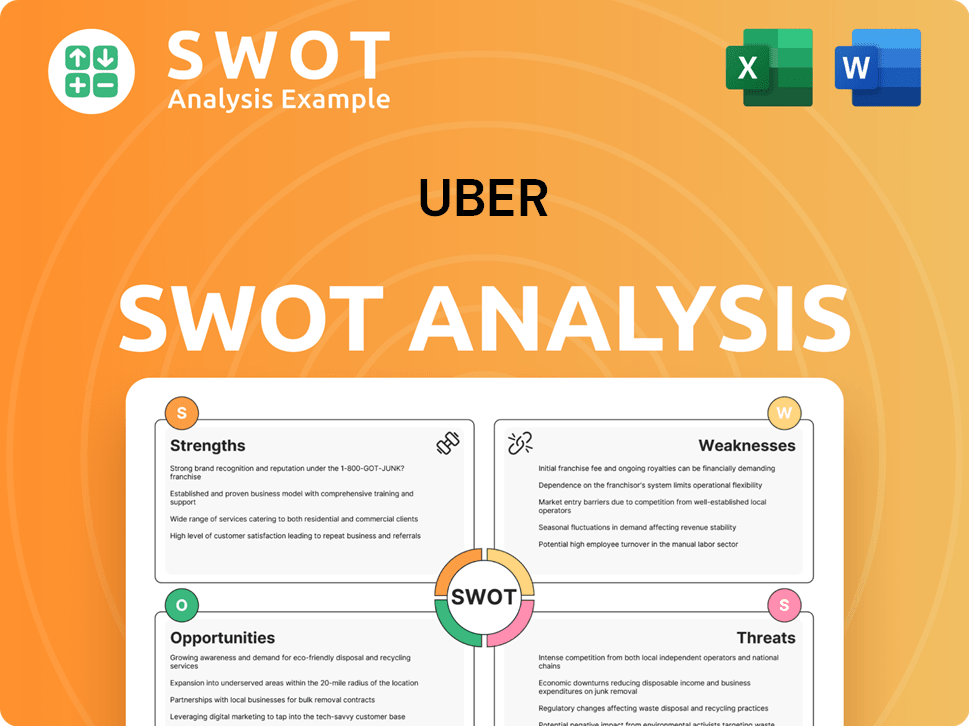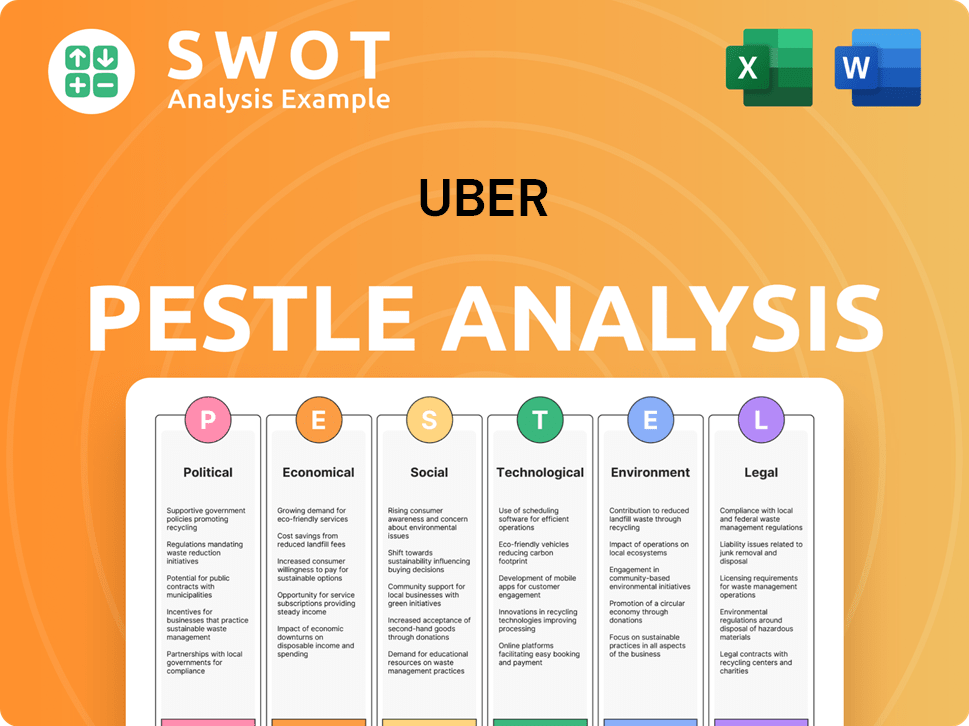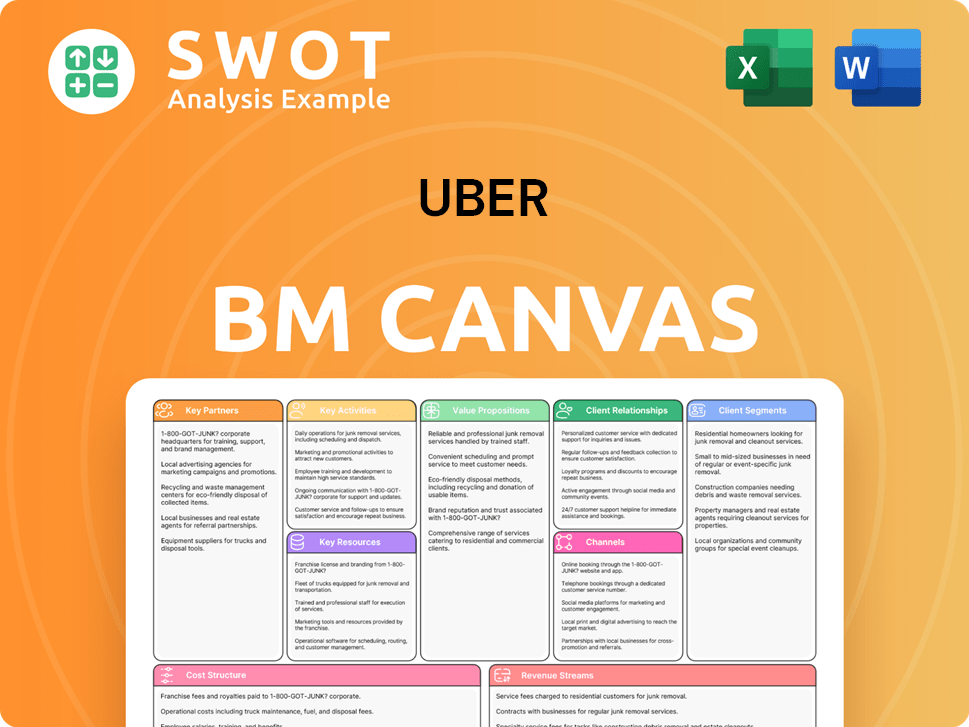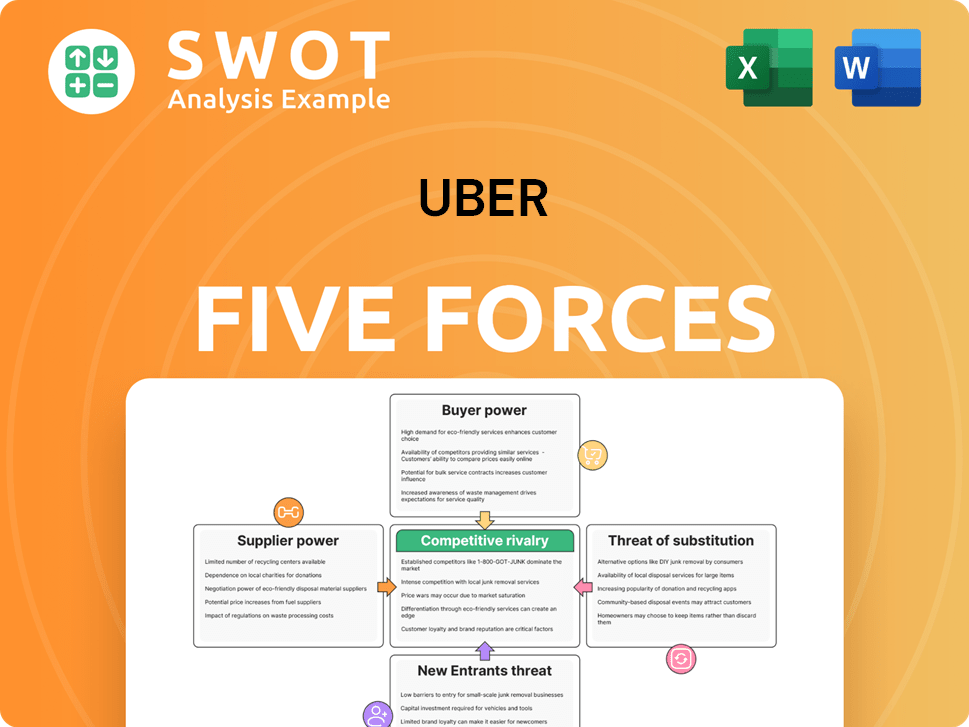Uber Bundle
Can Uber Maintain Its Dominance in the Cutthroat Mobility Arena?
Uber's journey from a luxury car service to a global mobility giant is a testament to its disruptive power. But in the ever-changing landscape of the ride-sharing industry, staying ahead requires more than just innovation; it demands a deep understanding of the Uber SWOT Analysis and its competitive landscape. This analysis delves into the complex web of Uber competitors, market dynamics, and strategic positioning that define its success.

As of early 2025, the ride-sharing industry is fiercely contested, with numerous transportation network companies vying for market share. This exploration will provide a comprehensive Uber market analysis, examining its competitive advantages, including its global competitive strategy, and how it differentiates itself from rivals. We'll dissect the challenges faced by Uber's competitors and assess the impact of regulations, all while evaluating Uber's financial performance compared to its key players.
Where Does Uber’ Stand in the Current Market?
Uber holds a significant market position across its operational segments. The company's core offerings include ride-hailing (Rides), food delivery (Uber Eats), and logistics (Uber Freight). Uber's global presence spans over 10,000 cities across more than 70 countries as of early 2025, allowing it to serve a diverse customer base.
In the ride-hailing sector, Uber is a global leader, maintaining a strong market share in numerous key cities and countries. Uber has diversified its offerings beyond its initial premium car service to include more budget-friendly options like UberX, and expanding into micro-mobility with bikes and scooters in some markets. This diversification has allowed the company to cater to a wider range of consumer needs and preferences.
Financially, Uber has shown improving health and scale. For the fourth quarter of 2024, Uber reported robust revenue growth and increased profitability. This financial performance, combined with its expansive global network and diversified service portfolio, positions Uber as a formidable entity within the on-demand economy. The Target Market of Uber has been a key factor in its success.
Uber maintains a strong presence in the ride-sharing industry. In the United States, Uber consistently holds a significant market share, often competing with Lyft. Gross bookings in the ride-sharing segment have reached substantial figures, reflecting Uber's continued strong performance.
Uber operates in over 10,000 cities across more than 70 countries as of early 2025. This extensive reach allows it to serve a broad spectrum of customer segments. Uber’s global presence is a key factor in its competitive strategy.
Uber's financial results for the fourth quarter of 2024 showed strong revenue growth and increased profitability. This improved financial health supports Uber's competitive position. The company's ability to generate revenue and manage costs is crucial.
Uber has expanded beyond ride-hailing to include Uber Eats and Uber Freight. This diversification allows Uber to capture multiple revenue streams. The company's ability to adapt to market demands is a key strength.
Uber's market share and financial performance are key indicators of its competitive position. The company's success is tied to its ability to maintain a strong presence in the ride-sharing industry, expand its service offerings, and improve its financial health.
- Uber's continued strong performance in the ride-sharing segment.
- Robust revenue growth and increased profitability reported in the fourth quarter of 2024.
- Global presence in over 10,000 cities across more than 70 countries.
- Diversification into food delivery and logistics services.
Uber SWOT Analysis
- Complete SWOT Breakdown
- Fully Customizable
- Editable in Excel & Word
- Professional Formatting
- Investor-Ready Format

Who Are the Main Competitors Challenging Uber?
The Uber competitive landscape is complex, encompassing a variety of direct and indirect rivals across its diverse business segments. Analyzing Uber competitors reveals a dynamic market where innovation and strategic positioning are critical. Understanding the Uber market analysis is essential for grasping the challenges and opportunities the company faces.
Uber's operations span ride-hailing, food delivery, and freight services, each with its own set of competitors. These competitors range from established industry players to emerging startups, all vying for market share. The ride-sharing industry, transportation network companies, and the broader mobility as a service sector all contribute to the competitive pressures Uber experiences.
The competitive environment is constantly evolving due to technological advancements, changing consumer preferences, and regulatory changes. For a detailed look at how Uber approaches its long-term goals, consider reading about the Growth Strategy of Uber.
In North America, Lyft is Uber's primary direct competitor in ride-hailing, competing directly on price, driver availability, and user experience. Globally, Uber faces competition from regional giants like Didi Chuxing, Grab, and Bolt. These competitors often have strong local market knowledge.
Uber Eats competes with DoorDash and Grubhub in the United States. DoorDash has gained significant market share in the U.S. food delivery space. Internationally, Uber Eats faces competition from Deliveroo and Glovo.
Uber Freight competes with traditional logistics companies, freight brokers, and digital freight matching platforms. The competition focuses on efficiency, network size, and technological integration.
Indirect competition comes from public transportation, traditional taxis, car ownership, and alternative delivery methods. New tech-driven startups are constantly emerging, attempting to disrupt specific niches.
Strategic alliances and mergers, such as Uber's acquisition of Postmates, have reshaped competitive dynamics and market consolidation. The industry is characterized by rapid innovation and changing consumer demands.
In 2024, DoorDash held approximately 60% of the U.S. food delivery market share, while Uber Eats held around 30%. Lyft's market share in the U.S. ride-sharing market was approximately 30% compared to Uber's 70%. Uber Freight's revenue in 2024 was approximately $2.2 billion.
Uber's competitive advantages include its brand recognition, extensive network, and technological platform. However, it faces challenges from competitors focused on specific geographic areas or niche markets.
- Price and Promotions: Competitors frequently use aggressive pricing strategies.
- Driver and Courier Availability: Ensuring a sufficient supply of drivers is crucial.
- User Experience: App usability, reliability, and customer service are key differentiators.
- Geographic Coverage: Expanding into new markets and maintaining a strong presence.
- Technological Innovation: Continuous improvements in app features and services.
Uber PESTLE Analysis
- Covers All 6 PESTLE Categories
- No Research Needed – Save Hours of Work
- Built by Experts, Trusted by Consultants
- Instant Download, Ready to Use
- 100% Editable, Fully Customizable

What Gives Uber a Competitive Edge Over Its Rivals?
Understanding the Uber competitive landscape requires a deep dive into its multifaceted advantages. These advantages have allowed the company to dominate the ride-sharing industry. The core of Uber's success lies in its strategic moves, including technological innovation and a strong brand presence.
Uber's journey has been marked by key milestones, from its initial launch to its global expansion. These strategic moves have enabled it to build a robust network and establish itself as a leader in the transportation network companies sector. Analyzing these factors is crucial for understanding Uber's market analysis.
The company's competitive edge is further sharpened by its ability to adapt and innovate within the rapidly evolving mobility landscape. The company has consistently refined its services, personalized user experiences, and optimized operations. This continuous improvement cycle has been a key driver of its success.
Uber's technology includes sophisticated algorithms for dynamic pricing, efficient driver-rider matching, and optimized routing. This infrastructure allows for seamless service delivery and operational efficiencies. Uber's intellectual property in these areas gives it a significant edge over its Uber competitors.
As more riders use Uber, more drivers are incentivized to join, leading to shorter wait times and more reliable service. This self-reinforcing cycle creates a powerful barrier to entry for new competitors. Uber's vast global distribution network, encompassing millions of drivers and delivery personnel, further solidifies this advantage.
The brand 'Uber' is widely recognized, often used to refer to ride-hailing services. This recognition fosters customer loyalty and trust. The company benefits from economies of scale, allowing it to invest heavily in technology, marketing, and expansion. This scale is difficult for smaller competitors to match.
Uber leverages data analytics to refine its services, personalize user experiences, and optimize operations. This provides a continuous loop of improvement. These advantages have evolved from its early focus on convenience and luxury to its current emphasis on efficiency and platform integration.
While some advantages, such as brand recognition, are relatively sustainable, others, like technological lead, require continuous innovation. Uber's ability to adapt to industry shifts and maintain its competitive edge is crucial for its long-term success. The company's focus on innovation and expansion is a key factor in understanding the future of the ride-sharing industry and Uber.
- Market Share: In 2024, Uber holds a significant market share in many regions, often exceeding 60% in major cities.
- Revenue Growth: Uber's revenue has shown consistent growth, with recent reports indicating a year-over-year increase of over 15%.
- Geographic Expansion: Uber continues to expand its operations into new markets, with a focus on emerging economies.
- Service Diversification: Uber has diversified its services to include food delivery (Uber Eats), freight transportation, and other mobility solutions.
Uber Business Model Canvas
- Complete 9-Block Business Model Canvas
- Effortlessly Communicate Your Business Strategy
- Investor-Ready BMC Format
- 100% Editable and Customizable
- Clear and Structured Layout

What Industry Trends Are Reshaping Uber’s Competitive Landscape?
The Uber competitive landscape is significantly shaped by evolving industry trends, presenting both challenges and opportunities. The ride-sharing industry, dominated by transportation network companies, is undergoing rapid transformation due to technological advancements and changing consumer preferences. Understanding Uber's market analysis and its position relative to Uber competitors is crucial for strategic decision-making in this dynamic environment.
Risks include regulatory changes and the emergence of new mobility solutions, while opportunities lie in emerging markets and product innovations. Adapting to these changes, innovating service offerings, and navigating the regulatory landscape are key to Uber's future success. For more details, you can explore the Revenue Streams & Business Model of Uber.
Technological advancements in autonomous vehicles and AI are reshaping the ride-sharing industry. Regulatory scrutiny of the gig economy and shifts in consumer preferences towards sustainable transportation are key trends. The rise of Mobility as a Service (MaaS) platforms and the expansion of delivery services are also influencing the market.
Challenges include the impact of autonomous vehicles on the driver-partner model and the need for significant investments in technology. Regulatory changes, such as labor law reforms and driver classification, pose risks. Increased competition from new market entrants and pricing strategies from competitors also present hurdles.
Significant growth opportunities exist in emerging markets, where urbanization and smartphone penetration are increasing demand. Product innovations, such as expanding delivery services and integrating with public transit, offer potential. Strategic partnerships can also enhance Uber's competitive position and facilitate expansion.
Uber's competitive position is influenced by its ability to adapt to trends, innovate, and navigate regulations. Key factors include pricing strategies, market saturation, and data privacy concerns. The company's global strategy and partnerships play a crucial role in its sustained success.
Uber's future hinges on several key factors. These include adapting to technological advancements, managing regulatory challenges, and capitalizing on emerging market opportunities. The company must also focus on product innovation and strategic partnerships to maintain its competitive edge.
- Autonomous Vehicle Integration: The successful integration of autonomous vehicles could drastically reduce operational costs.
- Regulatory Compliance: Navigating evolving labor laws and driver classifications is crucial for long-term sustainability.
- Market Expansion: Focusing on high-growth markets and expanding service offerings can drive revenue.
- Technological Innovation: Leveraging AI for routing, pricing, and customer service is essential.
Uber Porter's Five Forces Analysis
- Covers All 5 Competitive Forces in Detail
- Structured for Consultants, Students, and Founders
- 100% Editable in Microsoft Word & Excel
- Instant Digital Download – Use Immediately
- Compatible with Mac & PC – Fully Unlocked

Related Blogs
- What are Mission Vision & Core Values of Uber Company?
- What is Growth Strategy and Future Prospects of Uber Company?
- How Does Uber Company Work?
- What is Sales and Marketing Strategy of Uber Company?
- What is Brief History of Uber Company?
- Who Owns Uber Company?
- What is Customer Demographics and Target Market of Uber Company?
Disclaimer
All information, articles, and product details provided on this website are for general informational and educational purposes only. We do not claim any ownership over, nor do we intend to infringe upon, any trademarks, copyrights, logos, brand names, or other intellectual property mentioned or depicted on this site. Such intellectual property remains the property of its respective owners, and any references here are made solely for identification or informational purposes, without implying any affiliation, endorsement, or partnership.
We make no representations or warranties, express or implied, regarding the accuracy, completeness, or suitability of any content or products presented. Nothing on this website should be construed as legal, tax, investment, financial, medical, or other professional advice. In addition, no part of this site—including articles or product references—constitutes a solicitation, recommendation, endorsement, advertisement, or offer to buy or sell any securities, franchises, or other financial instruments, particularly in jurisdictions where such activity would be unlawful.
All content is of a general nature and may not address the specific circumstances of any individual or entity. It is not a substitute for professional advice or services. Any actions you take based on the information provided here are strictly at your own risk. You accept full responsibility for any decisions or outcomes arising from your use of this website and agree to release us from any liability in connection with your use of, or reliance upon, the content or products found herein.